Opinion Article, Arch Clin Pathol Vol: 6 Issue: 2
The Intersection of Clinical Microbiology and Epidemiology
Pascual Phan*
Department of Clinical Microbiology, University of Barcelona, Barcelona, Spain
*Corresponding Author: Pascual Phan
Department of Clinical Microbiology,
University of Barcelona, Barcelona, Spain
E-mail: phan@pascual.edu.cat
Received date: 28 May, 2023, Manuscript No. ACPY-23-107060
Editor assigned date: 31 May, 2023, Pre QC No. ACPY-23-107060 (PQ);
Reviewed date: 14 June, 2023, QC No. ACPY-23-107060
Revised date: 22 June, 2023, Manuscript No. ACPY-23-107060 (R);
Published date: 28 June, 2023, DOI: 2324-8955/acpy.05.03.100085
Citation: Phan P (2023)The Intersection of Clinical Microbiology and Epidemiology. Arch Clin Pathol 6:2.
Description
Clinical microbiology and epidemiology are two interconnected fields that play vital roles in understanding and controlling infectious diseases. Clinical microbiology focuses on the identification and characterization of microorganisms that cause infections, while epidemiology is concerned with the patterns, causes, and effects of diseases in populations. The convergence of these disciplines is essential for effective disease surveillance, outbreak investigation, and the development of appropriate prevention and control strategies. This study discuss the intersection of clinical microbiology and epidemiology, highlighting their collaborative efforts in disease detection, monitoring, and response.
Clinical microbiology and epidemiology collaborate closely in disease surveillance and outbreak investigation. Clinical microbiologists work in diagnostic laboratories, where they analyze patient samples to identify the causative agents of infectious diseases. They use various laboratory techniques, such as culture, molecular diagnostics, and serology, to detect and characterize pathogens. Epidemiologists rely on these microbiological data to identify patterns, trends, and sources of infections. By analyzing the microbiological profiles of infected individuals and comparing them with epidemiological data, they can track the spread of diseases, identify clusters of cases, and investigate potential sources of outbreaks.
Epidemiologists often collaborate with clinical microbiologists to conduct epidemiological investigations of infectious diseases. These investigations involve identifying risk factors, modes of transmission, and susceptible populations. Clinical microbiologists provide essential information about the pathogens involved, their antimicrobial susceptibility patterns, and any emerging drug resistance. By combining microbiological and epidemiological data, investigators can gain insights into the dynamics of disease transmission and guide public health interventions.
Antimicrobial resistance is a global public health concern. Clinical microbiologists play a significant role in monitoring antimicrobial resistance patterns and detecting emerging resistant strains. They conduct susceptibility testing to determine the effectiveness of various antibiotics against bacterial isolates. Epidemiologists use this data to track the prevalence and spread of drug-resistant pathogens, identify risk factors for resistance development, and inform antimicrobial stewardship programs. The collaboration between clinical microbiology and epidemiology is essential for understanding the impact of antimicrobial resistance on patient outcomes and developing strategies to combat this growing threat.
Clinical microbiology and epidemiology are integral to the development and surveillance of vaccines. Clinical microbiologists contribute to vaccine development by providing essential information on the target pathogens, their antigenic properties, and the selection of appropriate vaccine strains. Epidemiologists play a vital role in vaccine surveillance, monitoring vaccine efficacy, and identifying any breakthrough infections or vaccine failures. They analyze data on disease incidence, vaccine coverage, and vaccine response rates to assess the effectiveness and impact of vaccination programs.
Collaboration between clinical microbiology and epidemiology is essential for designing and implementing effective public health interventions. Clinical microbiologists provide dire information on the infectious agents, their reservoirs, and modes of transmission. Epidemiologists analyze epidemiological data to identify at-risk populations, develop targeted prevention strategies, and evaluate the impact of interventions. By working together, these disciplines can guide the implementation of infection control measures, outbreak response, contact tracing, and targeted vaccination campaigns.
The intersection of clinical microbiology and epidemiology is a dynamic and essential component of infectious disease management. Their collaboration is vital for disease surveillance, outbreak investigation, antimicrobial resistance monitoring, vaccine development, and public health interventions. By combining their expertise, clinical microbiologists and epidemiologists can generate comprehensive insights into the epidemiology, transmission, and control of infectious diseases. This collaborative effort is essential for protecting public health, preventing the spread of infections, and improving patient outcomes.
